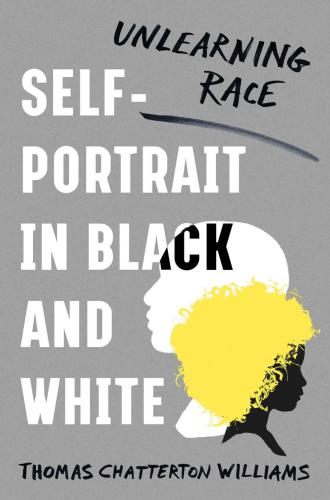
Self-Portrait in Black and White
Family, Fatherhood, and Rethinking Race
کتاب های مرتبط
- اطلاعات
- نقد و بررسی
- دیدگاه کاربران
نقد و بررسی

August 1, 2019
A standout memoir that digs into vital contemporary questions of race and self-image--among the most relevant, "What is proximity to the idea of whiteness worth and what does color cost? And the reverse?" Williams (Losing My Cool: How a Father's Love and 15,000 Books Beat Hip-Hop Culture, 2010), a 2019 New America Fellow and contributing writer at the New York Times Magazine, moves away from the "Black Man" label to offer a chronicle of why he is aiming to think of himself as "an ex-Black Man." Raised in the 1980s in New Jersey by a "black" father and a "white" mother, the author grew up thinking of himself as black. The trigger for writing this lyrical, incisive memoir was the birth of his daughter in 2013, followed by a son. They are also mixed-race given the author's marriage to Valentine, a Frenchwoman. (The family resides in Paris.) Though Williams is determined to move beyond categorizations of "black" and "white," in order to communicate clearly in this memoir, he knows he must rely heavily "on our language's descriptive conventions," which he explains in the opening author's note. We see the author's psychological struggle as he thinks through the conundrums, including what the confusion might mean for his white-looking children. In the hands of a lesser writer, the back and forth of his pondering could have sunk the memoir. However, it succeeds spectacularly for three main reasons: the author's relentlessly investigative thought process, consistent candor, and superb writing style. Almost every page contains at least one sentence so resonant that it bears rereading for its impact. The lengthy prologue is grounded heavily in discussions of race as a social construct. Part 1 takes readers through Williams' adolescence, Part 2 through his marriage, and Part 3 through dealing with his family on both sides. In the epilogue, the author speculates on "the shape of things to come." Shelve this one alongside Kiese Laymon's Heavy, Mitchell Jackson's Survival Math, and Imani Perry's Breathe. An insightful, indispensable memoir.
COPYRIGHT(2019) Kirkus Reviews, ALL RIGHTS RESERVED.

Starred review from August 5, 2019
Williams (Losing My Cool) follows in the footsteps of James Baldwin and Ta-Nehisi Coates to craft a provocative philosophical argument about the role of race in human identity. He acknowledges during this trio of essays that he has had some highly unusual experiences. “The View From Near and Far” deals with his youth as the light-skinned son of a black father and a white mother; his first trip to France, where many people thought he was of Middle Eastern descent; and his realization that identity is heavily influenced by the way others see a person. “Marrying Out” explores his marriage to a white French woman and how his father conveyed to him that black American life is “conditioned by local historical circumstance... not beholden to it.” “Self-Portrait of an Ex-Black Man” leads up to Williams’s decision to follow in artist Adrian Piper’s footsteps by “retiring” from race. Claiming the uniqueness of the black experience, he argues, is still buying into the racist idea that race is a centrally important facet of identity. The solution, he posits, is to live in “the humanizing specificity” of people as people, not as vessels for historicized prejudice. Regardless of whether readers agree with his conclusions, these essays are intellectually rigorous, written in fluid prose, and frequently exhilarating.

September 1, 2019
New York Times Magazine contributing writer Williams (Losing My Cool) probes his own experiences and ponders the future of his biracial daughter, Marlow, to explore dimensions of personal and group identity. He excoriates the social construction of "race," illustrating its illusions by parsing what he considers to be an anachronistic and fading lexicon that the black-white conceptual binary of the one-drop rule has imposed. The essentialism of groups such as "blacks" and "whites," or of conceptions such as a "black sensibility" or "black culture," exposes illogical racial classifications, he maintains. Williams also insists that counterproductive fictions confuse labels with lived experience and reduce individuals from actualities to abstractions. Arguing for transformational exchange in order to break the tortuous cycle of racial determinism, Williams asserts the self-healing potential to renounce race and transcend racism at an interpersonal level. VERDICT Provocative in its review of and reflections on race and racism amid continuing de facto segregation, this work argues that personal identity does not exist as a checked box. It promises to appeal to readers willing at least to consider unlearning race so as to imagine a future without it and advance his vision of a multigenerational transformation of social repair.--Thomas J. Davis, Arizona State Univ., Tempe
Copyright 2019 Library Journal, LLC Used with permission.

September 15, 2019
In his coming-of-age memoir, Losing My Cool (2010), Chatterton-Williams chronicled his youthful battle between the bookish life his parents modeled and the hip-hop culture he saw exalted on BET. The seed for this book grew from his first child's birth; with Marlow's blond curls and blue eyes, would anyone know her father was Black? Her arrival gave him "a closer glimpse of the fluidity of racial borders," prompted a self-examination, and led to his rejection of "the all-American skin game that demands you select a box and define yourself by it." This resulting memoir is almost the very definition of thought-provoking, asking readers to reconsider race from every angle. (An author's note explains his method for using traditional race-related descriptors mostly in italics or quotes.) Blending in his research and interviews with other scholars and addressing topics like class and 23andme findings, Chatterton-Williams meets his every provocation with searching questions and reasoned thought. And he ends with hope: "We can simultaneously resist bigotry and imagine a society that has outgrown the identities it preys on."(Reprinted with permission of Booklist, copyright 2019, American Library Association.)

























دیدگاه کاربران